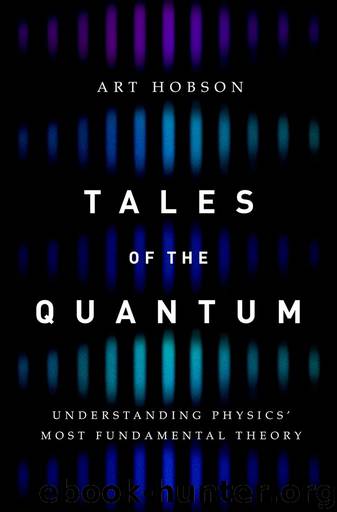Tales of the Quantum by Hobson Art;

Author:Hobson, Art;
Language: eng
Format: epub
Publisher: Oxford University Press, Incorporated
Published: 2016-09-16T16:00:00+00:00
Figure 8.2 Evidence of quantum superposition in the experiment shown in Figure 8.1 with the second beam splitter inserted. The fractional number of photons impacting detector 1 for various differences in length between path 1 and path 2. This fractional number is the probability that any single photon will be detected at detector 1. As we’ll see below, this graph shows that each photon travels both paths, interfering with itself at the detectors.
This is all quite odd. To see just how odd, let’s compare the two cases when the difference in path lengths is zero (so that all photons impact detector 1) and when this difference is 0.5 wavelength (so all photons impact detector 2). This change from a path difference of zero to a path difference of 0.5 wavelength can be achieved either by lengthening path 1 or by shortening path 2 by half a wavelength. Thus, every photon responds to changes in either path 1 or in path 2. So every photon must incorporate data about both paths. After all, if any of the photons followed only one of the two paths, it would not change it’s behavior when the other path was altered. The only reasonable description of this situation is “each photon travels by both paths.” Each photon is in a superposition of being on both paths simultaneously.
This odd situation might be hard to believe, but it’s not hard to visualize. Imagine the photon, pictured in Figure 8.1 just before it enters the interferometer, traveling simultaneously along both path 1 and path 2 within the interferometer—just like a water wave that separates into two superposed directions of motion. I will refer to these as the two branches of the superposition, referring to them separately as branch 1 and branch 2.
---------
To make sense of superposition, you must visualize quanta as waves in fields. The common picture of quanta as tiny things, like billiard balls only smaller, contradicts the extensive experimental evidence of superposition. If a quantum is like a billiard ball, it cannot travel two branches simultaneously. In fact, the notion that an individual quantum can be in two places simultaneously led Einstein, in 1927, to make perhaps his earliest recorded objection to quantum theory.4 If a superposed quantum is actually detected in one of its two branches, it must vanish instantaneously from the other branch, which could be kilometers away. Einstein argued this violates relativity’s injunction against instantaneous action across a distance. However, you’ll see later (Chapters 9 and 10) that quantum superposition actually does not violate the theory of relativity, because relativity forbids only the transmission of energy or information at speeds faster than light, and the simultaneous vanishing of a quantum from one branch and detection in the other branch does not involve such transmission.
When you accept the notion that a quantum is a wave, the explanation of the interferometer experiment is simple. Each quantum simply spreads out to travel both paths, just as a water wave can travel in two directions simultaneously. Based on this picture, the explanation of the experimental result of Figure 8.
Download
This site does not store any files on its server. We only index and link to content provided by other sites. Please contact the content providers to delete copyright contents if any and email us, we'll remove relevant links or contents immediately.
The Complete Stick Figure Physics Tutorials by Allen Sarah(7135)
Secrets of Antigravity Propulsion: Tesla, UFOs, and Classified Aerospace Technology by Ph.D. Paul A. Laviolette(4980)
Thing Explainer by Randall Munroe(3782)
The River of Consciousness by Oliver Sacks(3414)
The Order of Time by Carlo Rovelli(3072)
How To by Randall Munroe(2911)
I Live in the Future & Here's How It Works by Nick Bilton(2841)
A Brief History of Time by Stephen Hawking(2819)
What If?: Serious Scientific Answers to Absurd Hypothetical Questions by Randall Munroe(2542)
The Great Unknown by Marcus du Sautoy(2533)
Midnight in Chernobyl by Adam Higginbotham(2386)
Blockchain: Ultimate Step By Step Guide To Understanding Blockchain Technology, Bitcoin Creation, and the future of Money (Novice to Expert) by Keizer Söze(2379)
Networks: An Introduction by Newman Mark(2264)
The Meaning of it All by Richard Feynman(2213)
Easy Electronics by Charles Platt(2207)
The Tao of Physics by Fritjof Capra(2164)
Midnight in Chernobyl: The Untold Story of the World's Greatest Nuclear Disaster by Adam Higginbotham(2075)
When by Daniel H Pink(2020)
Introducing Relativity by Bruce Bassett(2018)
